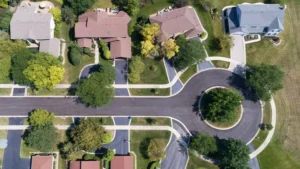
It’s not Trump and it’s not the Congress. I’m talking about something much closer to home.
It’s the cul de sac.
Cul de sacs have been a standard part of urban design for almost 80 years, since the end of World War II. They’re the product of an age when land uses – homes, stores, workplaces – were kept strictly separate. They’re a product of the automotive age.
This is a feature, not a bug. As Wikipedia notes, “Dead ends are added to roads in urban planning designs to limit traffic in residential areas.” Cul de sacs eliminate “cut through traffic,” directing all drivers to the main road. This forces cyclists who want to leave their cul de sacs onto 5-lane streets, next to cars going past at 60 mph and more. It’s where the resentment of bikes by cars, and the deaths of cyclists at the hands of cars, comes from.
Cul de sacs were designed when everyone used a car for everything. Cars are noisy, and they’re dangerous. It’s valuable not to have them racing down your street, and cul de sacs prevent that. But cul de sacs turn public spaces, the roads that are our transit system, into private spaces, which only residents can use. In the 21st century, this is very bad public policy.
The Ride to Lidl
I created the linked ride a few months ago, in preparation for my trip to the Netherlands next month.
When I made it, I was thinking that the ride might seem difficult to a Netherlander. It’s a full 3 kilometers and takes 9 minutes. There are hills, and I don’t even use the motor for the first half of the ride. In Maarssen, the flat Utrecht suburb I’ll be staying, this is a 1 kilometer ride and is said to take 4 minutes.
But I realized recently that’s not the problem. That’s because Kirkwood, the Atlanta neighborhood where I live, was designed early in the 1900s as a grid, with streets that connect with each other. Over time, people driving through moved to faster roads around its perimeter. As a result, you can bike from my home to Lidl as fast as you can drive there, because you’re taking a direct route.
This is important because it’s unique. If I ride outside Kirkwood, to the east or the north or the south, I quickly enter the world of cul de sacs. A ride like this becomes impossible, if you care about safety.
The Enemy
When suburban developers move into urban places, they bring cul de sacs. That is, if a developer sees a big piece of urban land and decides to build residences on it, there will be only one entrance and exit, directed toward the widest street.
For e-transport to work, we need to segregate it from the main highways. We need to take direct routes, bike-width paths, limiting their use to vehicles going under 15-20 miles per hour.
Bikes and e-bikes are quiet. If the paths are designed correctly, there should be no fear of cars or thieves traveling through pristine suburbs. You’ll see families, kids and moms, maybe a few dads and students heading for offices and college labs.
But I guarantee that if you propose cutting through a cul de sac, anywhere in America, you’re going to face overwhelming opposition. People are going to scream about the taking of property, but they’re really going to be worrying about people from outside cutting through their neighborhoods and (somehow) committing crimes. Never mind that you can’t carry much on a bike. Never mind the commonsense security, like cameras you can put on the path to identify riders.
Yet this is a fight worth having, because until we give everyone what I have on my Trip to Lidl, e-bikes won’t reach the mass market, and we’ll be locked in our rolling living rooms forever.










